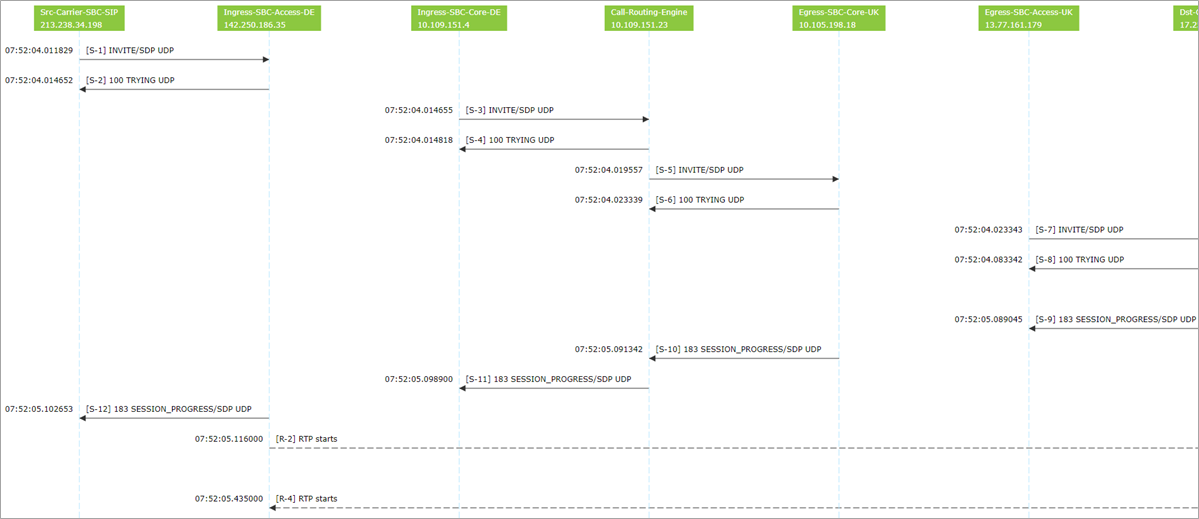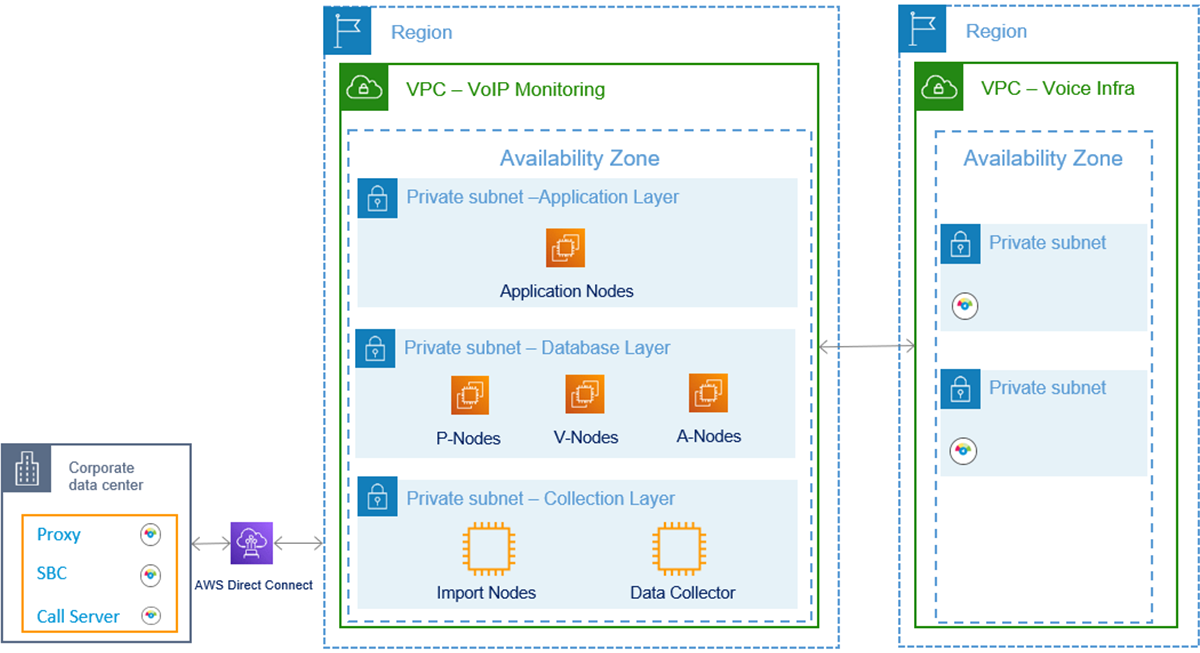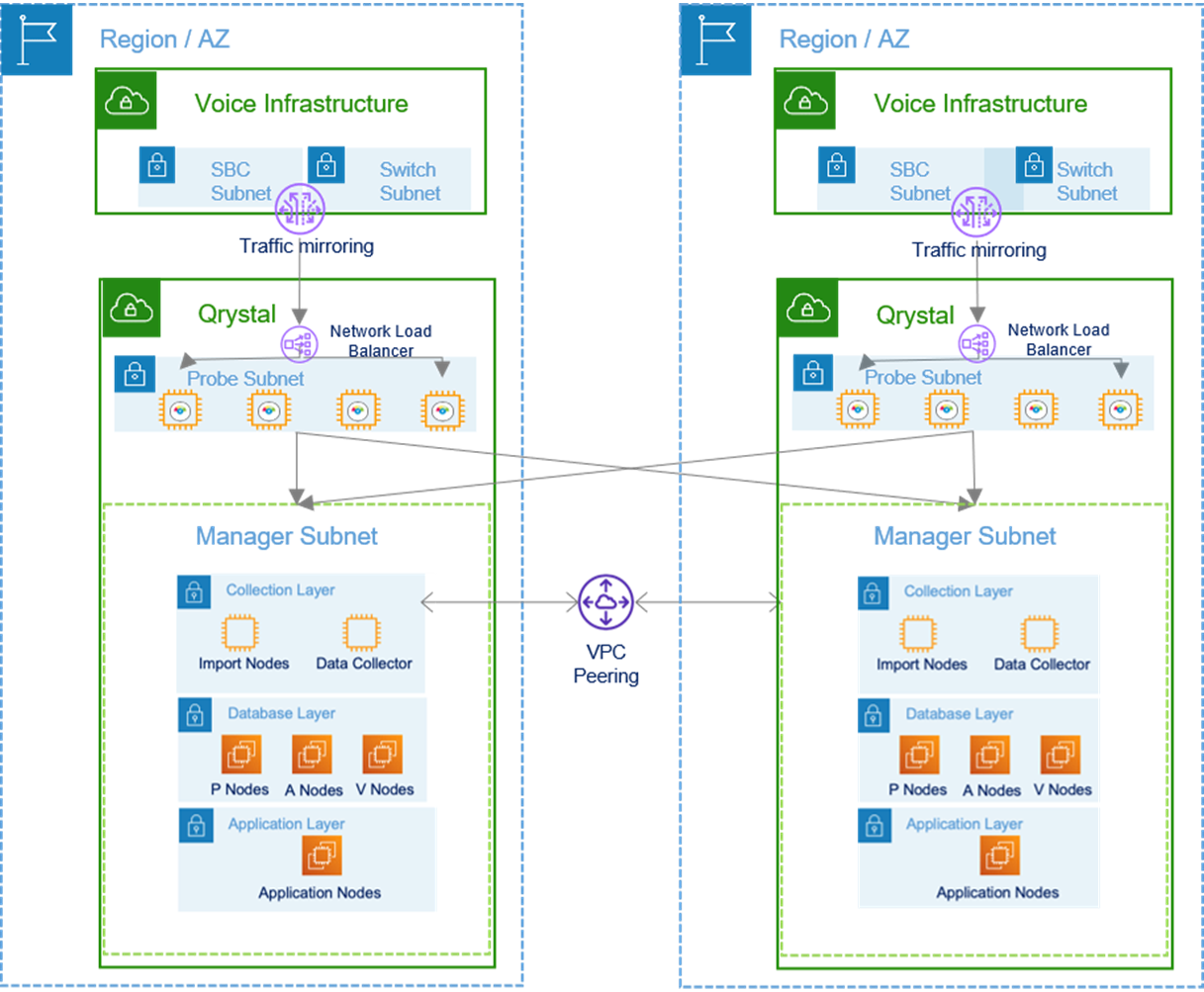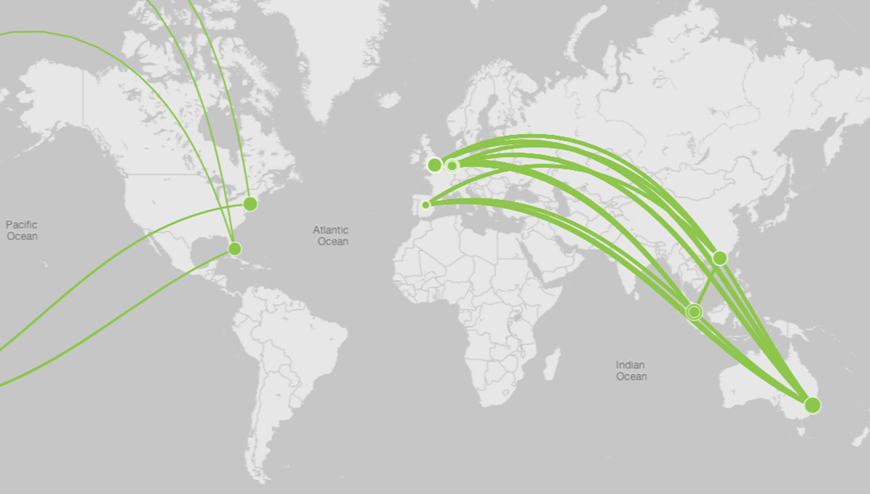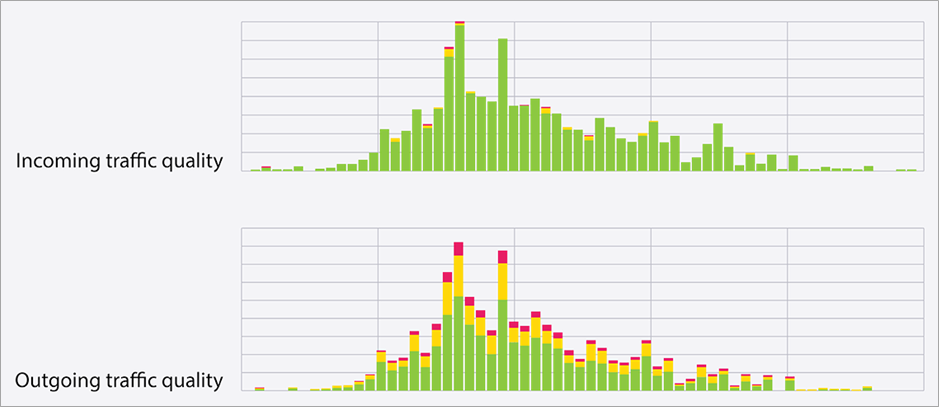AWS Partner Network (APN) Blog
Ensuring Visibility When Transitioning Voice Services to AWS with Voipfuture
By Hemant Rawat, Sr. Solutions Architect – AWS
By Dr. Michael Wallbaum, Director of Product Marketing – Voipfuture
 |
| Voipfuture |
 |
Voice services play a significant role across many industries by enabling real-time and critical communications. Building the computing infrastructure internally to deliver a high-quality voice service involves considerable capital and operational expenses, while also limiting the company’s flexibility to deal with unforeseen events and service requirements.
Given how the pandemic dramatically changed where and how we work, the shift to cloud and the proliferation of “X as a service” businesses have only accelerated. In a world of remote work, the idea of on-premises voice infrastructure restricting functionality to specific locations no longer works.
Cloud voice services and unified communications as a service, or UCaaS which refers to exchanging all forms of communication across a network, are consequently one of the areas seeing dramatic growth.
Businesses worldwide have seen the benefits of running voice infrastructure on Amazon Web Services (AWS) and moving on from legacy systems. AWS delivers computing resources for a range of different functionalities, enabling businesses to focus on delivering a rich customer experience.
One of the challenges in delivering exceptional customer experience is the lack of visibility into the network, which is essential to understand and control the actual user experience.
Voipfuture is an AWS Partner that offers Qrystal for AWS, a platform that provides visibility into your voice services. In this post, we discuss the current challenges in monitoring voice call quality and how Qrystal for AWS can be used to bring enriched visibility into your critical communication infrastructure.
The Operations Trade-Off
While moving voice services to the cloud seems like a no-brainer for modern enterprises, the transition process is not without complication. Specifically, service operations may face an apparent trade-off between the cloud’s flexibility and service visibility.
Businesses need tools and services that can help them reap the cloud’s benefits while providing complete visibility across the entire network and cloud. When using the cloud, the key to maintaining service quality and creating a user experience that matches customer expectations is access to reliable, accurate, and actionable data.
With high-quality data on your side, you can understand network performance, identify the root cause of any issue, and create the best user experience possible. Practical voice monitoring data offers deep insights and valuable information that produces tangible results, like reducing mean time to repair (MTTR). This improves service quality and can save costs through better service management and increased operational efficiency.
AWS and Voipfuture Eliminate the Trade-Off
When transitioning your voice service to AWS, there is no trade-off to be made. AWS and Voipfuture help to control call quality during the entire service lifecycle, through the Qrystal for AWS monitoring solution that:
- Analyzes all call-related traffic in AWS (and on premises if needed).
- Automatically identifies problems such as dropped or silent calls.
- Provides accurate and fast root cause analysis.
- Aggregates data to provide valuable statistics and KPIs.
- Assures high user experience that meets all customer expectations.
Qrystal for AWS data genuinely represents the end-user experience by allowing communication service providers to maintain control of their end product while enjoying all of the benefits AWS has to offer.
Voipfuture offers analytics services that deliver accurate data on any standard voice service and network, analyzing every packet of every call for connectivity and media quality.
This data provides an extensive analysis of cloud voice services to improve operations, creates genuine benchmarks (user experience KPIs) for sales teams to attract new customers, and delivers auto-detection that immediately spots issues as they arise.
Qrystal for AWS provides high temporal detail through time-slicing, according to ETSI TR 103 639. Time-slicing opens up myriad ways to aggregate data and generate effective media KPIs that reflect the call quality that end users perceive.
Qrystal for AWS is a passive mid-point monitoring solution for SIP/RTP-based real-time communication services. It consists of distributed Qrystal Probes and the central Qrystal Manager. Qrystal for AWS Probes receive a copy of the network traffic through VXLAN tunnels.
Figure 1 – Qrystal system components and their connection to the voice network.
Qrystal Probes
Qrystal Probes determine the signaling and media stream characteristics at multiple points in the network:
- The probes analyze all SIP, RTP, and RTCP packets on a link in real time and generate unique metrics for further processing by the Qrystal Manager.
- Call-related SIP signaling at a monitoring point is analyzed and summarized as xDRs. SIP messages are stored on the probe for display in call flow diagrams.
- Voipfuture’s patented fixed time slicing technology creates quality data records (QDR), containing highly condensed statistical information for every five-second segment of an RTP stream. QDRs hold several hundred values, ratios, KPIs, and even automatic root cause indicators.
- Qrystal Probes also support smart packet recording to create traces of individual calls or trunks.
Qrystal Manager
Qrystal Manager is at the heart of the solution, featuring a carrier-grade data warehouse:
- Qrystal Manager collects all metric data from the Qrystal Probes for post-processing, correlation, and aggregation. KPIs, quality-enriched CDRs, and other data are stored in the data warehouse.
- Qrystal Manager offers a multitude of analytics and troubleshooting capabilities that enable effective voice service monitoring and fault alarming, as well as numerous interfaces for integration with OSS/BSS applications.
Qrystal covers all aspects of voice quality assurance, including registration monitoring, call monitoring, reporting, quality-enriched CDRs and call flow diagrams, alarming, a highly flexible call search, automated indicators, custom dashboards, and more.
Figure 2 – Screenshot from the Qrystal user interface showing a call flow diagram.
Effective Voice Service Monitoring
Qrystal for AWS provides a cloud-based voice monitoring solution with integrated control and media plane analytics. The Qrystal architecture supports large-scale deployments and shortens the time-to-fix by up to 80% through automatic root cause detection, timeslicing, and behavioral analysis.
The system features a robust, highly scalable, multi-tier architecture that is suitable for deployments of all sizes. Specifically, systems distributed over multiple AWS Availability Zones (AZs) will benefit from Qrystal’s probing approach and correlation capabilities.
Probes are placed in the same AZ as the monitored network elements and links. They process the traffic on-site and only upload a detailed quality summary to the Qrystal Manager. The compression factor of actually monitored traffic to the volume of quality summaries is about 1/2000 or 0.05%. This greatly reduces the costs of hauling traffic between AZs compared to other solutions. Still, the system is able to provide a clear end-to-end picture of all calls thanks to its advanced multi-level correlation capabilities.
Figure 3 – Qrystal system architecture overview.
AWS Reference Architecture
A standard Qrystal for AWS deployment consists of identical Amazon Elastic Compute Cloud (Amazon EC2) instances inside an Amazon Virtual Private Cloud (Amazon VPC). The different types of Manager nodes are deployed on separate layers with dedicated private subnetworks.
Figure 4 – Reference architecture for Qrystal on AWS.
The Qrystal Probes receive the voice traffic through VPC traffic mirroring. This Amazon VPC feature lets you copy network traffic from your voice infrastructure (SBC, call server, proxies) to the Probes. Traffic mirroring copies inbound and outbound traffic from the network interfaces that are attached to your instances.
A deployment can be scaled at any time to increase storage capacity and processing power.
AWS CloudFormation is used to fully manage the creation, deletion, management, and configuration of the deployment.
AWS Direct Connect enables a dedicated private network connection from your data center to the AWS region. This is useful for monitoring on-premises infrastructure if not all of the voice service infrastructure is deployed in the AWS Cloud.
Highly Available Architecture
The solution is designed to be highly scalable and has a high availability (HA) deployment option. High availability is achieved by deploying an active standby copy of the Qrystal Manager in a different Availability Zone.
As for non-HA deployments, Qrystal Probes are placed close to the data source in order to minimize data transfer costs. This eliminates the need for Probe HA, as Probes reside in the same location as the voice infrastructure. In case an individual Qrystal Probe goes down the system continues to work without that probe, so minimal data is lost.
Figure 5 – Example architecture with replication over different AWS regions and AZs.
Large deployments may require sending the mirrored traffic to a Network Load Balancer that has a UDP listener, or a Gateway Load Balancer that has a UDP listener, instead of directly to the network interface of a Qrystal Probe instance.
The traffic mirror source and traffic mirror target (Qrystal instances) can be in the same VPC. Or they can be in different VPCs that are connected through intra-region VPC peering, a transit gateway, or by a Gateway Load Balancer endpoint to connect to a Gateway Load Balancer in a different VPC.
Monitoring Use Cases
Qrystal for AWS is designed as a complete vertical solution delivering business-critical information to all organizational units of a business. Statistics and detailed call-level data deliver essential insights to different teams, including:
- Network operations and troubleshooting
- Customer experience management
- Network and service performance optimization
- Marketing
A variety of interfaces to third-party system, facilitates its integration with existing IT infrastructure and AWS services like Amazon QuickSight and Amazon SageMaker.
One example of a live Qrystal deployment is provided by a leading global provider of fully-integrated consumer engagement, workforce optimization, and self-service omnichannel solutions. A long-time AWS Partner, the UCaaS provider integrated its enterprise-class workforce optimization solution with AWS’s cloud-based contact center Amazon Connect.
Recently, the company extended its AWS Cloud offering to voice services. Voipfuture, acting as the voice quality assurance vendor of choice, was asked to introduce Qrystal for AWS. Voipfuture installed three Qrystal Probes in three different AZs and one dedicated Qrystal Manager in the AWS Cloud to monitor up to 3,000 concurrent calls during peak times.
Qrystal for AWS ensures the provider can verify service and network performance using AWS for inbound and outbound calls, routes, destinations, and individual agents.
Below is an example for a dashboard of a service operations team. The aggregated signaling and media performance of voice traffic is presented in a concise way. Each line corresponds to a carrier and each column to a destination. The different sections show a selection of voice service KPIs, namely NER, SER, ACD and the MOS.
Figure 6 – Dashboard for a network operation center of a voice service provider.
The same data is also used to raise alarms when anomalies are detected. The accuracy of Qrystal’s data makes it a robust foundation for artificial intelligence (AI) and machine learning (ML) services such as Amazon SageMaker and Lookout for Metrics. This helps to automatically detect network anomalies, quickly detect root causes, and raise adaptive alarms for further analysis.
Another business customer uses Qrystal’s accurate statistical data to monitor the network performance between the different data centers spread across the globe. Clicking on a link between two data centers allows to drill-down to individual calls and even RTP timeslices.
Figure 7 – Map showing route quality of an international voice carrier.
Troubleshooting Use Cases
Qrystal statistics also simplify the troubleshooting process. Consider a scenario where an enterprise begins receiving complaints about voice quality from its customers. In addition, staff at the business are also noticing broken voices and other voice-related issues.
Using its Qrystal Probes, the company could see where and how good and bad traffic is moving around its network. A Probe at a specific access router measured good traffic entering and bad traffic leaving the router.
Figure 8 – Media quality of RTP streams entering and leaving an access router.
Once the root cause was detected, the company could drill down to identify the specific issue. In this instance, periodic packet loss and jitter were impacting the stream of RTP packets. Analysis showed the network management software (NMS) polling the router once every minute. Deactivating the NMS polling solved the problem, and no more complaints were received.
Conclusion
The use case examples highlighted in this post show how Voipfuture’s Qrystal for AWS enables enterprises to reap the benefits of deploying voice services on AWS while maintaining full visibility and ensuring a high-quality service. As a result, cloud voice service deployments become fast, safe, and flexible while providing a user experience satisfying customer expectations.
AWS and Voipfuture closely collaborate to ensure companies moving to AWS benefit from the operational efficiency and flexibility of the cloud, without struggling to get the visibility they need to ensure the high-quality service their customers expect. AWS makes it quick and easy to deploy and test even the most complex setups.
Qrystal for AWS is carrier-grade and vendor-agnostic, offering a proven assurance solution for voice services on the AWS Cloud.
Voipfuture – AWS Partner Spotlight
Voipfuture is an AWS Partner and provider of voice service assurance solutions. Their technology delivers a precise view on service performance and in-call user experience for 4G/5G, IMS, NGN and enterprise VoIP services.

